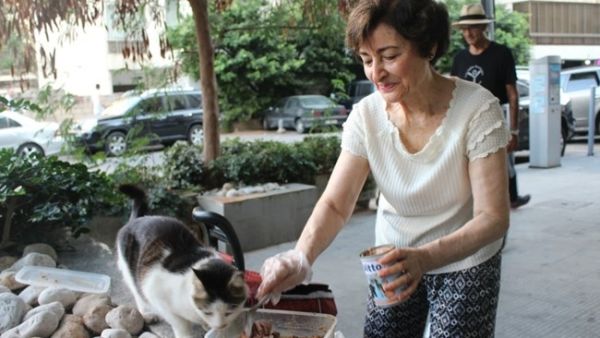A small army of stray cats appears from the shadows of a parking lot, surrounding a gray-haired woman in her mid-50s. Some are skin and bones, others are better-fed. Swirling around in a whirlwind of meows, it is clear that all are excited to see her. The woman’s name is Marianne and she comes to feed the cats every day of the week. She is one of several women in Beirut who have dedicated their lives to helping the city’s feline residents.
“People call us crazy, but I don’t care. What I do doesn’t harm anyone,” she tells The Daily Star, stroking her favorite - a white and orange cat with only three legs.
During the day, Marianne teaches literature at a local university.
But on this late summer evening, she is revealing the secrets of Ras Beirut’s burgeoning cat population and the work she and her friends - Vera, Laila and Hiam - do to look after it.
Neither Marianne nor anyone else knows the number of cats in Beirut.
In fact, no one knows for sure how or why cats came to live among humans in the first place.
While other once-wild animals were domesticated for their milk, meat or labor, beyond occasionally catching mice, cats make few practical contributions to our lives.
Recent studies suggest that cats probably started making themselves at home around people approximately 10,000 years ago. At this point, humans were developing into agricultural societies. By moving closer to us, it is believed that cats gained access to abundant supplies of mice and food scraps.
According to Habib Malik, professor of history at Lebanese American University, the Arab world has been fascinated by cats since ancient times.
“In Egypt they were worshipped. The Prophet Mohammad was said to have a favorite cat. And Iran is home to some of the finest breeds. In contrast to dogs, who are seen as filthy animals, no such negative stigma attaches to cats,” he says.
However, the historical status of cats has little bearing on the way they are treated today.
“The Middle East in general, and Lebanon as well, is not known for being kind to animals. On the whole, the attitude toward stray cats in Lebanon is to ignore them,” Malik says.
THIRTEEN YEARS FEEDING CATS
Vera does no such thing. Dressed in an elegant white blouse, with a neat pageboy hairstyle and shiny earrings, the 73-year-old feeds Hamra’s stray cats every day.
She says she buys 75 cans of cat food, 15 kilograms of dry food and four bags of chicken each week. She has been looking after street cats for 13 years, even though her family has tried to persuade her not to.
“Nobody else is taking care of them,” she says.
Her relatives are not the only ones complaining. Strangers on the street openly criticize her for devoting time to animals when so many people are in need. “The poor people can complain, cats can’t,” Vera often replies to them.
Nevertheless, the cat population of Beirut is still breeding and sustaining itself. In fact, according to Animals Lebanon, cats have been living on the streets for generations.
“Even if you could prevent any [more] cats from ever being abandoned, starting from tomorrow, you still have a population big enough to maintain itself,” Executive Director Jason Mier says.
The organization says the state should actively prevent stray cats from giving birth to more kittens through a sterilization program.
He adds that many of Beirut’s street cats are frequently run over by cars, that others have infections and that all of them eat trash.
“That’s why the population should be decreased in a humane way. But it’s not something an NGO can do,” Mier says.
APARTMENT FILLED WITH ANIMALS
Laila’s devotion to animals is clear as soon as she opens the door to her apartment - an 80-square-meter space, where she lives with 45 cats and 11 dogs. All of them are sick, injured or abandoned.
{"preview_thumbnail":"https://cdn.flowplayer.com/6684a05f-6468-4ecd-87d5-a748773282a3/i/v-i-7…","video_id":"78c642ff-5878-4357-9f43-74271bfd0277","player_id":"8ca46225-42a2-4245-9c20-7850ae937431","provider":"flowplayer","video":"Trump Expresses Support for Netanyahu in Coming Israeli Elections"}
She shares all of her rooms with animals. Inside, cages containing small kittens are stacked on top of one another. The smell of urine is strong and in the corner of the living room lies a dead kitten in a shoebox.
Laila used to work taking care of girls’ dormitories at American University of Beirut. However, she says she lost her job after washing a cat in the sink there.
Now, Laila dedicates her time to looking after the animals in her home. She says that she wants to keep her address a secret.
“People keep dumping animals at my place and I can’t handle any more,” she adds.
Some people donate money to help her. Her dream is to raise enough funds to move to the mountains, to a place with a garden and space for her animals.
“I am supposed to be 45 years old, but I feel like I am 75.
“I can’t keep doing this, but if I am not helping these animals they will die,” she says.
Then she gets a phone call. Someone has another animal in need of her assistance.
SERVING CATS AFTER DEATH
According to recent academic studies, cats are sensitive to depressive moods of humans.
Put another way, they are nice to us when we feel sad.
Research has also shown that they can clearly distinguish between individual humans.
Hiam is fully aware that cats recognize humans.
She feeds, talks to and nurses approximately 200 cats a day in various locations around Beirut.
She is also planning to devote her afterlife to cats, saying that she wants her grave to be a fountain for cats to drink from.
“My reward is to see the cats happy,” the 70-year-old says.
Since retirement in 1998, cats have been the focus of her life.
And, even though taking care of them has been stressful and economically draining, she says she feels it has been all worth it because “cats are more sincere than humans.”
“The cats are not just happy to see me because I give them food,” Hiam says.
“They like me. I knew another lady who used to feed them. When she died, the cats sat at her grave for a couple of months, almost as they were mourning her.
“There is a connection that is difficult to explain.”
This article has been adapted from its original source.








